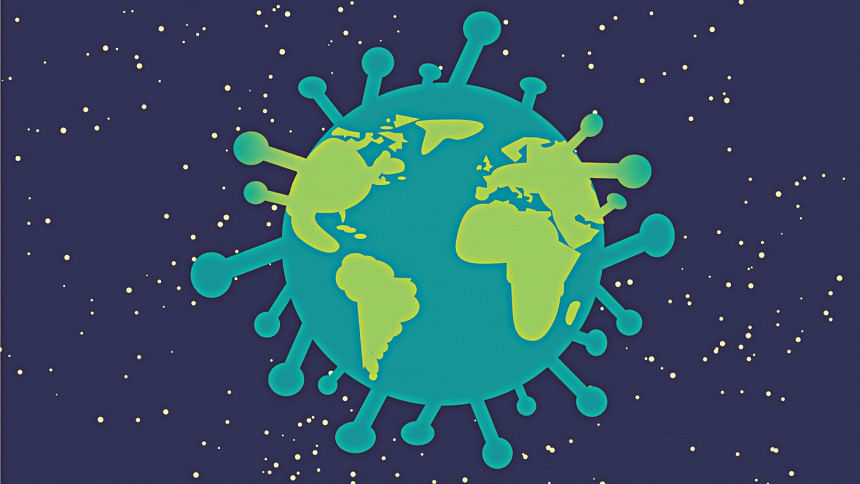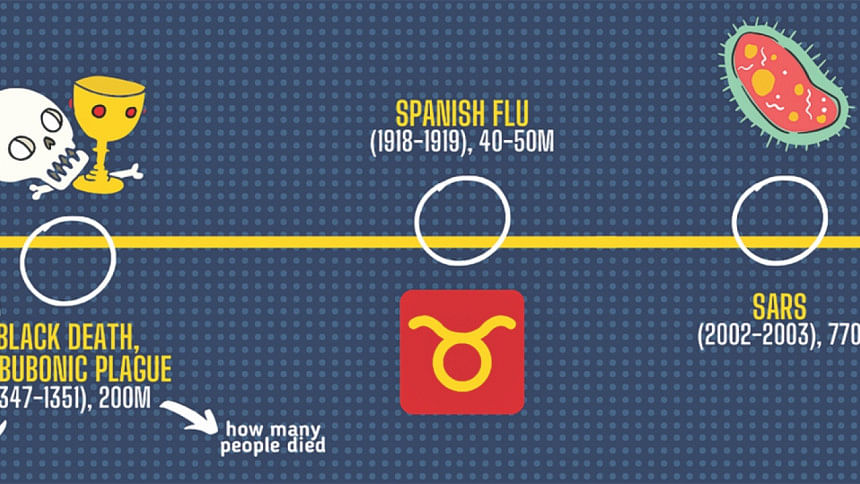Our fight with pandemics

Throughout history, time and again outbreaks have taken populations by surprise but human beings have always been able to walk out of the other end, although not completely unscathed but with new lessons that have helped them fight their next battle with the invisible enemy.
Before the advent of global transport networks, outbreaks usually remained contained in specific parts of the world but even in those days there were some diseases that have managed to wipe out civilisations across the world. The bubonic plague was one such disease. This plague was caused by the bacteria Yersinia pestis and had managed to travel the world on the back of rats by infected fleas.
The first pandemic caused by this plague is argued to have helped the fall of a Roman empire. The plague infected the emperor Justinian and hence this first pandemic was named after him and called the Plague of Justinian (541-542 AD). During that time, the spreading mostly occurred through sea ports where the infected rats could easily sneak in through the ships. The exact death toll is argued although eventually the disease wiped out about 40 percent of the population of Constantinople (Istanbul today). This disease did not leave our world immediately and the bacteria resurfaced again in the form of the infamous Black Death (1347-1351). This time the disease killed about one third of the European population. As far as we know, this particularly fatal bacterium is known to have caused three of the deadliest pandemics in our history.
Flash forward to modern times, outbreaks can spread much more easily now, resulting in pandemics. The most prevalent of them include the cholera and flu pandemics. The 1918 Spanish flu is one of the first unusually dangerous flu pandemics to hit the world which managed to wipe out about a quarter of the world's then population. It was caused by a sub-type of the influenza A virus called the H1N1 influenza virus. Other sub-types of this virus have caused other flu outbreaks such as the Asian flu (1957-1958), Hong Kong flu (1968-1969), and the most recent swine flu (2009).
Now, the question lies, how has the world coped with these pandemics? In the past, people had no idea about the spread of diseases. But when the Black Plague hit Europe in 1347, some of the people realised that getting sick had something to do with being near other sick people and began to stray clear of them. To further prevent the spread, whenever sailors arrived at shores, they were kept inside their ships for 30 days. In Venetian law, this was known as a trentino. Later on, the number of days was increased to 40, or quarantino,and this is where we get the word "quarantine" from.
Similar to this, with every new outbreak, humans have found more and more innovative ways to tackle the situation. Smallpox had been a deadly disease with unusually high mortality rates but this disease resulted in the invention of the vaccine and finally resulted in the complete eradication of a disease for the first time in recorded history. Cholera outbreaks were widespread in the 19th century when an intelligent British doctor named John Snow identified that contamination of the drinking water results in contraction of the disease. He emphasised on protecting drinking water from contamination and we largely have him to thank for improving global sanitation.
With much newer outbreaks such as that of HIV, we have had more knowledge and resources at our disposal. The disease was identified back in the 1980s and what's different with this pandemic is that, here, prevention worked much better than cure. Although there are still no effective vaccines, strategies preventing the spread of the disease have proven highly effective and drugs have been designed to prolong the life of the infected. Between the years 2005 and 2012, the yearly death toll had dropped significantly down to 1.6 million from 2.2 million. Although the disease is still present, it has been successfully contained.
The most recent pandemics have been the Severe Acute Respiratory Syndrome (SARS) (2002-2003) and swine flu (2009-2010) outbreaks. One striking difference between the current Covid-19 outbreak and all the previous outbreaks is the presence of social media. Although social media makes dissemination of information surrounding the disease much easier, it makes the spreading of misinformation just as easy. This results in the population having to fight against both the disease and the rumours surrounding it.
With each of these outbreaks, the health officials and the public find newer ways to cope and also become better prepared for future scenarios. We can always employ these previous lessons we have learnt but it's never easy to accurately predict the trajectory of a current outbreak since all of them are unique. One important lesson we can take away from the Covid-19 outbreak is how crucial personal hygiene such as washing hands can be.
This definitely will not be the last outbreak. With population numbers soaring and climate change, emergence of new diseases will become much more prevalent in the future. Therefore, all we can do is be prepared.
References
1. https://www.history.com/news/pandemics-end-plague-cholera-black-death-smallpox
2. https://www.visualcapitalist.com/history-of-pandemics-deadliest
The writer would love to get feedback. Send her an email at [email protected]


 For all latest news, follow The Daily Star's Google News channel.
For all latest news, follow The Daily Star's Google News channel. 



Comments